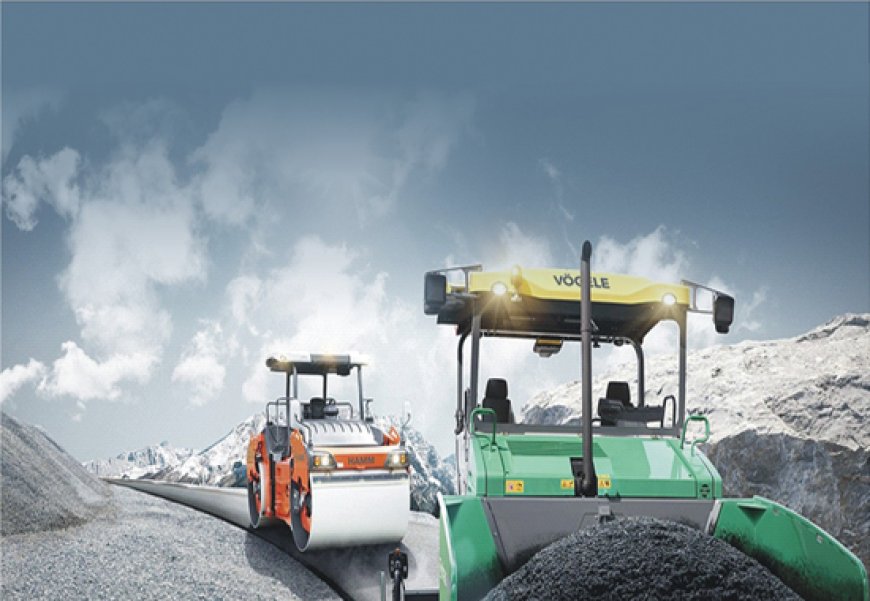Let’s Rap
Recycling of existing asphalt pavement material for making new pavements result into considerable savings in financial and material resources and energy. Asphalt roads with high percentage of reclaimed asphalt pavement, and use of recycled plastic is bound to emerge in

Recycling of existing asphalt pavement material for making new pavements result into considerable savings in financial and material resources and energy. Asphalt roads with high percentage of reclaimed asphalt pavement, and use of recycled plastic is bound to emerge in India.
Globally, we have witnessed amazing developments in the hot- mix production technology. In India too, with the entry of global players, OEMs have geared up to offer advanced plants that can produce a variety of mixes – be it low energy / low-temperature asphalt mixes, warm / cold mixes, high percentage RAP mix, high recycling technology. With a huge network of roads to be constructed the demand for asphalt plants is expected to surge. However, In India the adoption of these advanced technologies which could conserve virgin resources, bring down CO2 footprint, and considerably reduce fuel consumption and thereby, total cost of production, is still low.
Growth Opportunities
 India needs to address the huge infrastructure deficit that has existed since independence. Earlier, policy makers favoured concrete roads because the longevity of concrete roads was assumed / expected to be high. However, there seems to be a realization that asphalt roads are equally good and more eco-friendly. Apart from more national highways under the Bharatmala program, the demand for all-weather roads for better port-hinterland connectivity, as well for linking them with major highways, border roads, coastal roads, etc., will drive the demand for asphalt plants. Further, big ticket projects in new airport construction and modernization of some others, which will involve a substantial outlay on asphalt roads. Consequently, we expect the demand for hot mix plants to increase significantly, states Raj Shrivastav, Executive in Charge – Crushing, Screening & HMAP- TIL.
India needs to address the huge infrastructure deficit that has existed since independence. Earlier, policy makers favoured concrete roads because the longevity of concrete roads was assumed / expected to be high. However, there seems to be a realization that asphalt roads are equally good and more eco-friendly. Apart from more national highways under the Bharatmala program, the demand for all-weather roads for better port-hinterland connectivity, as well for linking them with major highways, border roads, coastal roads, etc., will drive the demand for asphalt plants. Further, big ticket projects in new airport construction and modernization of some others, which will involve a substantial outlay on asphalt roads. Consequently, we expect the demand for hot mix plants to increase significantly, states Raj Shrivastav, Executive in Charge – Crushing, Screening & HMAP- TIL.
The Indian road sector has entered the fast lane, with the highest ever kilometres being awarded last fiscal. The pace of construction, too is cruising having doubled to 27km per day currently, and expected to touch 32 km per day by fiscal 2020.The market has evolved to a great extent. The largest demand in this segment is in the range of 120 to 160 tonne per hour plants. The demand of higher capacity plants has risen due to large size projects which are awarded through hybrid annuity mode. However, some of the larger contractors are viewing RAP usage as a mainstay and installing higher capacity plants with the latest technologies,” states Ashok Tanna, Managing Director, Linnhoff India.
It’s Time to RAP
The current challenges in hot mix asphalt pavement making in India is to manage sustainability, conserving energy and natural resources, eliminating waste yet achieving the pavement quality with competitive cost per unit length. Key government and regulatory agencies in India e.g. MoRTH, NHAI, IRC,CPRI have initiated significant steps by encouraging recycling of existing asphalt in road making and maintenance in order to reduce carbon emission in the road construction activity besides capturing significant benefit in cost and energy saving. Research has shown that combining Warm-Mix Asphalt (WMA) and Reclaimed Asphalt Pavement (RAP) offers significant improvements in pavement performance. Recycling of existing asphalt pavement material for making new pavements result into considerable savings in financial and material resources and energy.
IRC has quite well adapted recycling in to the codes, however we are still far from what some countries committed to sustainable development specify. The use of RAP in the sub base layer is not the best use of the immense value available in the asphalt pavements. This could be a solution, however to promote more RAP, the codes must allow and encourage more use of RAP in the hotmix. The fear of the unknown must be wiped out and a fresh impetus to hot recycling is a must to save and make our country sustainable.
“The government has made good progress by allowing the use of Rap upto 30% in mix design. This saves the environment and also precious costs of bitumen. The government should push further into allowing use of RAP upto 70% in mix design wherein the pavement is usable. This will bring a huge reduction in project costs and also work as a green initiative for a better environment. The government should also incentivize the use of RAP, says Tanna.
“A great way to ensure preservation of resources in the course of road construction is by way of ensuring greater energy efficiency of asphalt plants, i.e. minimum consumption of diesel, and encouraging usage of Reclaimed Asphalt Pavement (RAP). This trend of asphalt roads, along with the use of RAP, being preferred over concrete roads is bound to emerge in India, sooner rather than later,” opines Shrivastav.
Tech-trends
Says Shrivastav “A rising trend is the use of reclaimed asphalt pavement (RAP) in asphalt mix to enable sustainable road construction, which is being encouraged by MoRTH, IRC, CRRI, NHAI and other agencies to reduce the carbon footprint of road construction. Use of RAP has been made mandatory by NHAI.” According to him the next big thing in India will be warm mix (WAM) produced with water foaming. It consumes at least 14% less energy, has better compaction and much longer resistance to fatigue (up to 13 times more) as per an independent long term lab studies in USA and Europe. There are positive benefits related to WMA production, including such things as reduced consumption of energy, significantly lower emissions, and elimination of visible smoke.
Recycled Plastic for Road Construction
Another major trend in the wings is the use of recycled plastic for road construction. Elucidating the advantages Tanna affirms, “Softened plastic have a binding property and can be mixed with binder like bitumen to enhance the property. This is a good modifier for the bitumen, used for road construction. Plastic can be widely used in pavement construction as it offers flexibility, strength between aggregates and bitumen. Concept of utilization of waste plastic in the construction of pavement has shown better resistance to water which reduces the stripping of bitumen from aggregate. The use of plastic thus contributes to construction of green roads.” And the company has already been on the go upgrading its plants to incorporate the use of waste recycled plastic. That’s a commendable development.
Selection Criteria
The choice of technology, capacity and capability of a hot mix asphalt plant is driven by the quality of pavement to be delivered against a contract, compliance to regulatory standards and emission regulation, total cost of ownership and cost of hot mix asphalt pavement per unit length, aftermarket support and reliability of the product to deliver the required uptime to be able to complete the asphalt pavement work within the stipulated period.
Economy, ecology and efficiency the three E’s that needs to be factored while opting for a asphalt plant. Faster set up time, quicker commissioning and easy in transport, are some other features that an end user looks forward. Understanding the numerous challenges that professional road contractors are facing world-over, most of the vendors have developed several solutions, which are becoming industry-trends. OEMs are offering high capacity plants which are mobile in order to reduce project execution time.
And to promote sustainable development and encourage recycling, vendors have developed plants which take asphalt recycling to the next level. These plants take care of the total impact on the environment. VOC’s, Cox, NOx, Sox are constantly monitored to ensure that the impact on the environment is just green.
Selection of the hot mix plant for the particular project is depends on many factors such as quantum of the bituminous works to be carried out, time duration available for the work, relevant specifications to be followed for the work, and the performance of the plant and quality of service provided by the Vendor. Parameters such as weather conditions, moisture content in aggregates, dusty environment etc impact the performance of a hot mix plant. In general, manufacturers will consider all these aspects while manufacturing the plants, normally the buyer will collect the technical specifications from the different suppliers and purchase the plant keeping the cost and their services
in mind.
Go Green
With millions of kilometers of roads unpaved and needing upgrade in India, the future of HMA industry is quite bright. Proper planning and execution of the road development program in India, has a very high potential to take the nation ahead in to prosperity. With new highway projects by NHAI and rural road projects being undertaken on a massive scale, the infrastructure sector is rapidly gaining traction after a slowdown. The government’s new policy initiatives and support have fueled the positive trends in this sector.
From the sustainable development perspective it has become imperative that road-building professionals go green. And it is heartening that more number of professional road- building companies are showing renewed interest in producing high content RAP, warm- mix, low energy mixes, specification mixes, cold- mixes, etc. The industry need to press for removing restrictions on the limit of recycling and making specifications purely based on performance parameters. This will ensure only high quality technologies are promoted.
However, processing of recycled asphalt and ensuring good quality of end mix requires proper knowledge and testing of the RAP. Awareness about the important parameters is the key to successful use of RAP.
And that is the way ahead…sustainable construction by reducing the energy consumption, bringing down the use of virgin materials by promoting the use of recycled plastic and reclaimed asphalt pavement…it is time to RAP!
Hits: 81








